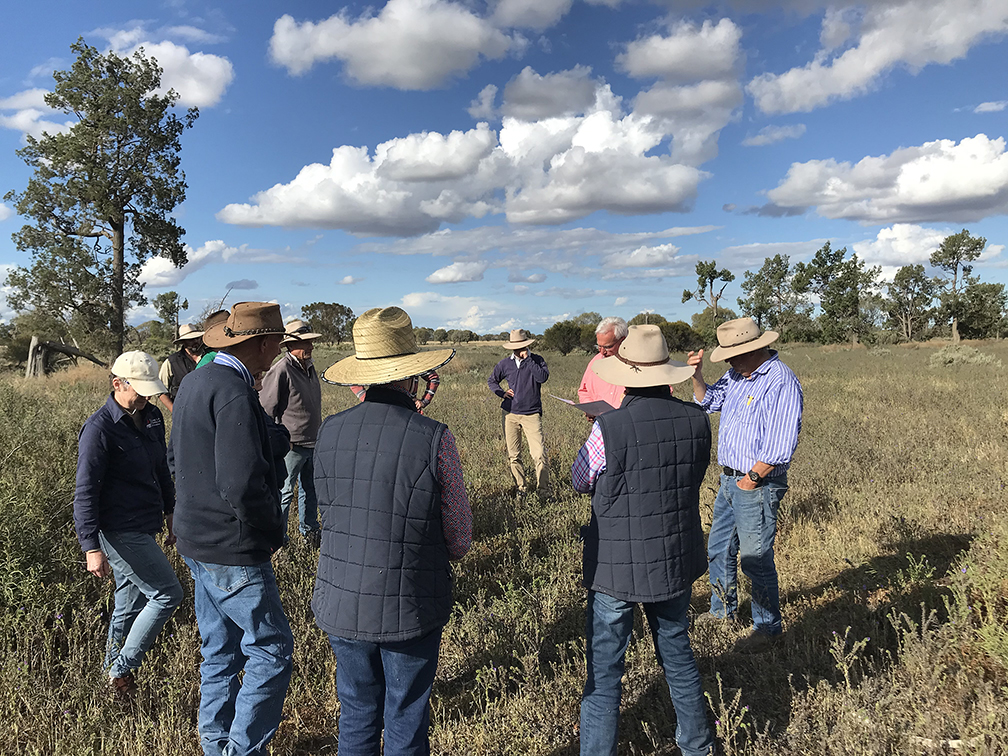Managing rangelands through tactical grazing
 PRODUCTION ADVICE - NOVEMBER 2020 - AGRONOMY
PRODUCTION ADVICE - NOVEMBER 2020 - AGRONOMY
By Adrian Smith
Senior Land Services Officer - Mixed Farming Systems
P: 03 5881 9932 | M: 0447 778 515 | E: adrian.smith@lls.nsw.gov.au
The agricultural areas of the Murray Local Land Services region are as diverse as they are productive. From snow-capped peaks of the Snowy Mountains in the upper Murray, to the rolling plains of the far-west – our area is certainly varied, changeable and charming.
The semi-arid rangelands of the north and west of the region are vast areas predominantly grazed by sheep – with cattle, goats and kangaroos also foraging on the fertile plains.
These grasslands are a mix of native and introduced species, annuals and perennials, shrubs, grasses and forbs, and they have a diversity of species and productive potential only truly appreciated by those who live and work in these areas.
While this diversity is a great strength, it can also make managing these areas extremely challenging.
Just consider some of the challenges these rangelands offer-up, including managing a range of:
- annual and perennial grasses and native shrubs – all of which have different growth patterns and rates, and are often productive and setting seed at different times of the year (and in response to rainfall).
- in some instances, native invasive species.
- animal production needs (quantity and quality of pastures, supplementary feeding, production or maintenance feeding).
- groundcover objectives (for production as well as to minimise erosion).
- water supplies that can often be of poor quality and not ideally located for grazing livestock.
- seasonally high fuel loads
- rabbits and goats.
These challenges in themselves are not uncommon to other graziers across our region – but when you combine it with generally low (and highly variable and unreliable) rainfall, extremes of temperature, additional grazing pressure from kangaroos and goats, variable and fragile soils (ranging from sandhills to clay plains – often in the one paddock!), problems associated with grass seed contamination (need I go on?), then you can start to get a sense of just how complex and challenging managing our semi-rangeland areas can be.
Let alone trying to make some money, and hopefully leaving the country in better condition into the future. No easy ask at all! Those producers who successfully manage these areas have unique skills and knowledge that should be heralded and applauded!
In this highly variable environment, there is no single recipe that graziers should implement. Rather, the approach should be more strategic and tactical, considering:
- establishing some objective(s) for your overall property and individual paddocks, such as maximising (short-term) productivity, maintaining paddocks which are in good condition, or trying to restore or regenerate paddocks that are degraded.
- developing some strategies that allow you to capitalise on opportunities (such as a good season) or minimise problems (such as drought) when they arise.
- observing how plants (and the animals grazing them) are responding to grazing and the weather conditions, and alter your management (such as stocking rates, stock removal at seeding etc) in a timely response to what you observe (and in line with your overall strategy).
- monitoring the results of your management – and changing something if it is either not working or not meeting your overall objective(s).
In reality, the ideal management required for a particular paddock may not be achievable at any one time and may vary both within and between seasons and years. But because of the fragile and highly variable nature of grazing in the semi-arid rangelands, the consequences of decisions on the financial performance of your business, and the land, water and forage resources you manage, can be significant.
Balancing these (often) competing factors can be difficult. However, implementing this ‘tactical’ approach to grazing can help producers make better decisions, allow compromises to be made (knowing what the consequences are likely to be) and result in better outcomes for the grazing business and the natural resource base.
 To gain a better understanding of how this tactical grazing can be implemented, a group of graziers from the Jerilderie district recently completed a two-day workshop. The workshop entitled ‘Tactical Grazing Management’ was run by NSW DPI in conjunction with Murray Local Land Services, and it provided producers with some important principles and concepts to consider around managing the rangelands, including:
To gain a better understanding of how this tactical grazing can be implemented, a group of graziers from the Jerilderie district recently completed a two-day workshop. The workshop entitled ‘Tactical Grazing Management’ was run by NSW DPI in conjunction with Murray Local Land Services, and it provided producers with some important principles and concepts to consider around managing the rangelands, including:
- identifying key plant and shrub species, and the roles they play.
- the importance of groundcover.
- managing different species, understanding the productivity and nutritional value of different species, and the needs of livestock.
- understanding the concept of total grazing pressure.
- the importance of monitoring to determine what impact(s) management decisions are having.
Feedback from the producers was overwhelmingly positive, and most left with a greater appreciation of, and confidence in, the range of management decisions and strategies they can implement.
If you’re interested in finding out more about managing your rangelands, or wish to take part in one of the workshops, contact the Deniliquin office of Murray Local Land Services on 03 5881 9900.